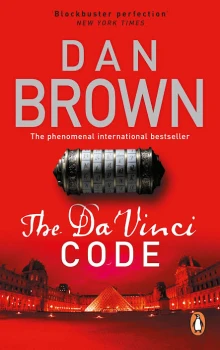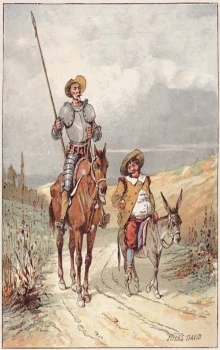The heavily forested park known as the Bois de Boulogne was called many things, but
the Parisian cognoscenti knew it as “the Garden of Earthly Delights.” The epithet, despite
sounding flattering, was quite to the contrary. Anyone who had seen the lurid Bosch
painting of the same name understood the jab; the painting, like the forest, was dark and
twisted, a purgatory for freaks and fetishists. At night, the forest's winding lanes were
lined with hundreds of glistening bodies for hire, earthly delights to satisfy one's deepest
unspoken desires—male, female, and everything in between.
As Langdon gathered his thoughts to tell Sophie about the Priory of Sion, their taxi
passed through the wooded entrance to the park and began heading west on the
cobblestone crossfare. Langdon was having trouble concentrating as a scattering of the
park's nocturnal residents were already emerging from the shadows and flaunting their
wares in the glare of the headlights. Ahead, two topless teenage girls shot smoldering
gazes into the taxi. Beyond them, a well-oiled black man in a G-string turned and flexed
his buttocks. Beside him, a gorgeous blond woman lifted her miniskirt to reveal that she
was not, in fact, a woman.
Heaven help me! Langdon turned his gaze back inside the cab and took a deep breath.
“Tell me about the Priory of Sion,” Sophie said.
Langdon nodded, unable to imagine a less congruous a backdrop for the legend he
was about to tell. He wondered where to begin. The brotherhood's history spanned more
than a millennium . . . an astonishing chronicle of secrets, blackmail, betrayal, and even
brutal torture at the hands of an angry Pope.
“The Priory of Sion,” he began, “was founded in Jerusalem in 1099 by a French king
named Godefroi de Bouillon, immediately after he had conquered the city.”
Sophie nodded, her eyes riveted on him.
“King Godefroi was allegedly the possessor of a powerful secret—a secret that had
been in his family since the time of Christ. Fearing his secret might be lost when he died,
he founded a secret brotherhood—the Priory of Sion—and charged them with protecting
his secret by quietly passing it on from generation to generation. During their years in
Jerusalem, the Priory learned of a stash of hidden documents buried beneath the ruins of
Herod's temple, which had been built atop the earlier ruins of Solomon's Temple. These
documents, they believed, corroborated Godefroi's powerful secret and were so explosive
in nature that the Church would stop at nothing to get them.”
Sophie looked uncertain.
“The Priory vowed that no matter how long it took, these documents must be
recovered from the rubble beneath the temple and protected forever, so the truth would
never die. In order to retrieve the documents from within the ruins, the Priory created a
military arm—a group of nine knights called the Order of the Poor Knights of Christ and
the Temple of Solomon.” Langdon paused. “More commonly known as the Knights
Templar.”
Sophie glanced up with a surprised look of recognition.
Langdon had lectured often enough on the Knights Templar to know that almost
everyone on earth had heard of them, at least abstractedly. For academics, the Templars'
history was a precarious world where fact, lore, and misinformation had become so
intertwined that extracting a pristine truth was almost impossible. Nowadays, Langdon
hesitated even to mention the Knights Templar while lecturing because it invariably led to
a barrage of convoluted inquiries into assorted conspiracy theories.
Sophie already looked troubled. “You're saying the Knights Templar were founded by
the Priory of Sion to retrieve a collection of secret documents? I thought the Templars
were created to protect the Holy Land.”
“A common misconception. The idea of protection of pilgrims was the guise under
which the Templars ran their mission. Their true goal in the Holy Land was to retrieve
the documents from beneath the ruins of the temple.”
“And did they find them?”
Langdon grinned. “Nobody knows for sure, but the one thing on which all academics
agree is this: The Knights discovered something down there in the ruins . . . something
that made them wealthy and powerful beyond anyone's wildest imagination.”
Langdon quickly gave Sophie the standard academic sketch of the accepted Knights
Templar history, explaining how the Knights were in the Holy Land during the Second
Crusade and told King Baldwin II that they were there to protect Christian pilgrims on
the roadways. Although unpaid and sworn to poverty, the Knights told the king they
required basic shelter and requested his permission to take up residence in the stables
under the ruins of the temple. King Baldwin granted the soldiers' request, and the
Knights took up their meager residence inside the devastated shrine.
The odd choice of lodging, Langdon explained, had been anything but random. The
Knights believed the documents the Priory sought were buried deep under the ruins—
beneath the Holy of Holies, a sacred chamber where God Himself was believed to reside.
Literally, the very center of the Jewish faith. For almost a decade, the nine Knights lived
in the ruins, excavating in total secrecy through solid rock.
Sophie looked over. “And you said they discovered something?”
“They certainly did,” Langdon said, explaining how it had taken nine years, but the
Knights had finally found what they had been searching for. They took the treasure from
the temple and traveled to Europe, where their influence seemed to solidify overnight.
Nobody was certain whether the Knights had blackmailed the Vatican or whether the
Church simply tried to buy the Knights' silence, but Pope Innocent II immediately issued
an unprecedented papal bull that afforded the Knights Templar limitless power and
declared them “a law unto themselves”—an autonomous army independent of all
interference from kings and prelates, both religious and political.
With their new carte blanche from the Vatican, the Knights Templar expanded at a
staggering rate, both in numbers and political force, amassing vast estates in over a dozen
countries. They began extending credit to bankrupt royals and charging interest in return,
thereby establishing modern banking and broadening their wealth and influence still
further.
By the 1300s, the Vatican sanction had helped the Knights amass so much power that
Pope Clement V decided that something had to be done. Working in concert with
France's King Philippe IV, the Pope devised an ingeniously planned sting operation to
quash the Templars and seize their treasure, thus taking control of the secrets held over
the Vatican. In a military maneuver worthy of the CIA, Pope Clement issued secret sealed
orders to be opened simultaneously by his soldiers all across Europe on Friday, October
13 of 1307.
At dawn on the thirteenth, the documents were unsealed and their appalling contents
revealed. Clement's letter claimed that God had visited him in a vision and warned him
that the Knights Templar were heretics guilty of devil worship, homosexuality, defiling
the cross, sodomy, and other blasphemous behavior. Pope Clement had been asked by
God to cleanse the earth by rounding up all the Knights and torturing them until they
confessed their crimes against God. Clement's Machiavellian operation came off with
clockwork precision. On that day, countless Knights were captured, tortured mercilessly,
and finally burned at the stake as heretics. Echoes of the tragedy still resonated in modern
culture; to this day, Friday the thirteenth was considered unlucky.
Sophie looked confused. “The Knights Templar were obliterated? I thought fraternities
of Templars still exist today?”
“They do, under a variety of names. Despite Clement's false charges and best efforts to
eradicate them, the Knights had powerful allies, and some managed to escape the Vatican
purges. The Templars' potent treasure trove of documents, which had apparently been
their source of power, was Clement's true objective, but it slipped through his fingers.
The documents had long since been entrusted to the Templars' shadowy architects, the
Priory of Sion, whose veil of secrecy had kept them safely out of range of the Vatican's
onslaught. As the Vatican closed in, the Priory smuggled their documents from a Paris
preceptory by night onto Templar ships in La Rochelle.”
“Where did the documents go?”
Langdon shrugged. “That mystery's answer is known only to the Priory of Sion.
Because the documents remain the source of constant investigation and speculation even
today, they are believed to have been moved and rehidden several times. Current
speculation places the documents somewhere in the United Kingdom.”
Sophie looked uneasy.
“For a thousand years,” Langdon continued, “legends of this secret have been passed
on. The entire collection of documents, its power, and the secret it reveals have become
known by a single name—Sangreal. Hundreds of books have been written about it, and
few mysteries have caused as much interest among historians as the Sangreal.”
“The Sangreal? Does the word have anything to do with the French word sang or
Spanish sangre—meaning ‘blood'?”
Langdon nodded. Blood was the backbone of the Sangreal, and yet not in the way
Sophie probably imagined. “The legend is complicated, but the important thing to
remember is that the Priory guards the proof, and is purportedly awaiting the right
moment in history to reveal the truth.”
“What truth? What secret could possibly be that powerful?”
Langdon took a deep breath and gazed out at the underbelly of Paris leering in the
shadows. “Sophie, the word Sangreal is an ancient word. It has evolved over the years
into another term . . . a more modern name.” He paused. “When I tell you its modern
name, you'll realize you already know a lot about it. In fact, almost everyone on earth has
heard the story of the Sangreal.”
Sophie looked skeptical. “I've never heard of it.”
“Sure you have.” Langdon smiled. “You're just used to hearing it called by the name
‘Holy Grail.' ”





